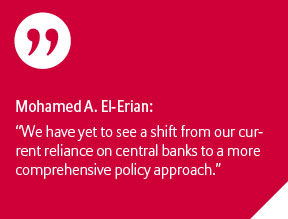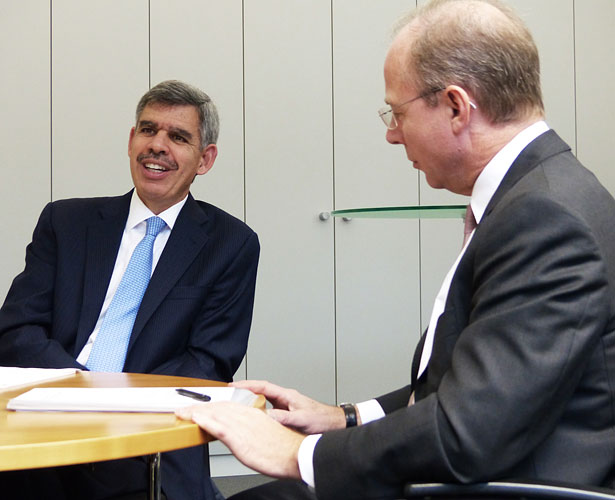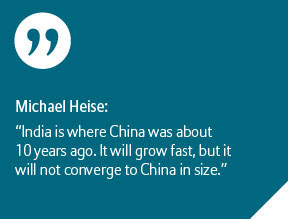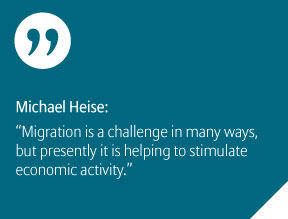Allianz.com: What kind of growth do you expect to see in 2016 and 2017 and what do you expect to be the main economic drivers?
Heise: I actually expect to see decent growth worldwide, though it will be different from what we saw last year. Growth will be stronger in the industrialized world and weaker in markets that depend on oil or commodity exports. The strong drop in the price of oil will be the main driver. If oil prices remain anywhere between 30 and 50 dollars per barrel, it will boost the consumption in the large majority of countries. That said, the price of oil is pretty difficult to predict.
El-Erian: The world economy will do OK, but it will fall short of a takeoff and of its potential and this despite ample cash on the sideline and exciting innovation. The main culprit is the partial policy response. We have yet to see a shift from our current reliance on central banks to a more comprehensive policy approach. So this policy handoff will be one of the central questions. We will also face higher financial volatility. The central question here is whether the volatility will remain contained to the financial markets or whether it will start affecting economic activity.
It seems that a lot depends on the central banks. Have they been overburdened since the 2008 financial crisis?
El-Erian: We can distinguish three phases here since the eruption of the global financial crisis in 2008. It all started with the “doing whatever it takes” response to the crisis. This prevented a worldwide depression and the breakup of the euro zone. The Federal Reserve Bank (Fed) and the European Central Bank (ECB) entered phase two in 2010 and 2014 respectively, when they took responsibility not only for monetary policy, but for the economy as a whole. Their measures helped generate some growth, but did not unleash new production capacities. Phase three will see pressure on unconventional policies. I would give central banks an A+ for the first phase and a B+ for the second phase. It is still too early to grade phase three.
Heise: As Mohamed says, we have been over-reliant on central banks. We cannot expect higher productivity or growth just by prescribing more of the same monetary medicine.
What boxing can teach us about the economy


The Fed has slowly begun to raise interest rates. When will Europe follow? What are the consequences of diverging policies of the Fed and the ECB?
Heise: Before it can raise interest rates, the ECB will have to start tapering its quantitative easing program. Since we currently expect this program to continue into 2017, we don’t foresee any movement away from zero interest rates before the second half of next year. And 2017 is already a very radical forecast, you can believe me.
El-Erian: Speaking from the standpoint of the Fed, there has been talk about four full rate hikes in 2016. I am expecting only two of them to actually take place at most. It could be less. And the interest rate cycle will remain shallow and will end well below the historical average of four percent.
We saw the first dip in the Chinese economy in 2015. This has even intensified in 2016. Are we facing a particularly volatile year?
El-Erian: China is currently facing what is an inevitable slowdown. As it transitions away from the middle-income stage, it will have to evolve its growth engines to greater reliance on domestic drivers. Then there is the sluggish global economy combined with previous and current policy slippages. For example, China wanted to encourage stock ownership and increase the stake of its citizens in market reforms. But like with US housing a decade ago, this went too far. China has to deal with this stock market bubble.
Will India become the new China? Will emerging markets continue to be an important driver of global growth?
Heise: Not in terms of size. The Chinese economy is about five times as large as India’s; that is, GDP of 10,000 billion euros compared to 2,000 billion euros. Let’s put it this way. India is where China was about 10 years ago. It will grow fast, but it will not converge to China in size.

What about the US and Europe?
Heise: Three factors are quite positive about Europe. The euro is cheap, oil prices are low and some substantial reforms have been put into place in recent years; Italy and France included. Due to these reforms, we have become less reliant on low oil prices and a cheap euro. Growth has become somewhat more self- sustained. And the current influx of asylum seekers in Europe, and in Germany in particular, will increase government spending and push private consumption growth over two percent. Migration is a challenge in many ways, but presently it is helping to stimulate economic activity.
El-Erian: Secular and structural headwinds still have to be overcome in the US and especially in Europe.
Mr. El-Erian, you use boxing metaphors in your new book “The only game in town”. Could you use Muhammad Ali and his upset of undefeated world heavyweight champion George Foreman as a metaphor to describe the global economy?
El-Erian: When Ali was pitted against Foreman for the legendary “Rumble in the Jungle”, he knew his current strategy wouldn’t work. So instead of trying to move like a butterfly and stinging like a bee, Ali used the ropes to absorb Foreman’s blows and to keep his head out of Foreman’s reach. By changing his tactic, Ali surprised Foreman and won the fight. What does this teach us? To be successful in the new global economy, we have to have three attributes: resilience, optionality and agility. Take Ali as an example and revisit your strategy from time to time.
Text/Interview: Andreas Klein

Further information
Forward Looking Statement disclaimer
As with all content published on this site, these statements are subject to our Forward Looking Statement disclaimer: